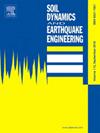Stability of slopes in partially saturated soils: Incorporating the combined effects of seismic forces and pore water pressure
IF 4.2
2区 工程技术
Q1 ENGINEERING, GEOLOGICAL
引用次数: 0
Abstract
Earthquakes and groundwater are pivotal factors affecting slope stability. However, the majority of previous studies have focused on these factors individually, neglecting their combined effects. Hence, this paper aims to develop a framework using the kinematic approach of limit analysis to investigate the stability of slopes in partially saturated soils under the combined effects of seismic force and pore-water pressure. The pseudo-dynamic method (PDM) was employed to capture the temporal-spatial effect of horizontal and vertical seismic waves. Variations in suction and effective unit weight profiles with moisture content under steady-state unsaturated flow were considered. External rates arising from both static pore-water pressure and earthquake-induced excess pore-water pressure were incorporated into the energy-balance equation. With the aid of gravity increase method (GIM), an explicit expression of safety factor (FS) was derived and optimized using a genetic algorithm (GA). The validity of this approach was verified through a comparison with existing solutions. Parametric analyses were conducted to explore the influence of varying groundwater level, seismic coefficients, suction, three-dimensional effects, excess pore water pressure, unsaturated flow types, and pseudo-dynamic parameters, on the FS and critical sliding surface of slopes in partially saturated slopes. This framework can provide a good reference for the safety design of reservoir slope under the combined effects of earthquakes and groundwater.
部分饱和土壤中斜坡的稳定性:地震力和孔隙水压力的综合影响
地震和地下水是影响斜坡稳定性的关键因素。然而,以往的研究大多集中于这些因素的单独影响,而忽略了它们的综合影响。因此,本文旨在利用极限分析的运动学方法建立一个框架,研究部分饱和土壤中斜坡在地震力和孔隙水压力共同作用下的稳定性。采用伪动力法(PDM)捕捉水平和垂直地震波的时空效应。考虑了稳态非饱和流动条件下吸力和有效单位重剖面随含水量的变化。在能量平衡方程中纳入了静态孔隙水压力和地震引起的过剩孔隙水压力所产生的外部速率。借助重力增加法(GIM),得出了安全系数(FS)的明确表达式,并使用遗传算法(GA)进行了优化。通过与现有解决方案的比较,验证了该方法的有效性。通过参数分析,探讨了不同地下水位、地震系数、吸力、三维效应、过剩孔隙水压力、非饱和流动类型和伪动态参数对部分饱和斜坡的安全系数和临界滑动面的影响。该框架可为地震和地下水共同作用下的水库边坡安全设计提供良好的参考。
本文章由计算机程序翻译,如有差异,请以英文原文为准。
求助全文
约1分钟内获得全文
求助全文
来源期刊

Soil Dynamics and Earthquake Engineering
工程技术-地球科学综合
CiteScore
7.50
自引率
15.00%
发文量
446
审稿时长
8 months
期刊介绍:
The journal aims to encourage and enhance the role of mechanics and other disciplines as they relate to earthquake engineering by providing opportunities for the publication of the work of applied mathematicians, engineers and other applied scientists involved in solving problems closely related to the field of earthquake engineering and geotechnical earthquake engineering.
Emphasis is placed on new concepts and techniques, but case histories will also be published if they enhance the presentation and understanding of new technical concepts.
 求助内容:
求助内容: 应助结果提醒方式:
应助结果提醒方式:


